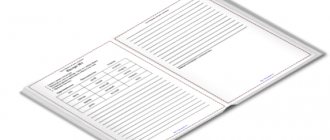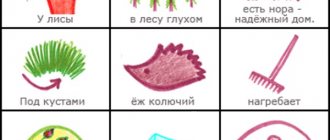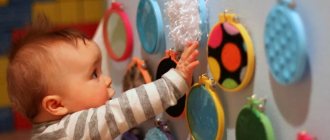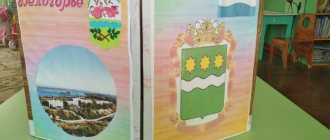Alysh remembers what he heard, so incorrect pronunciation, baby talk, dialects, and filler words are remembered very quickly. And as you know, retraining is more difficult than teaching. A preschool child will speak correctly when he hears correct literary speech. What are the components of speech? This is expressed in the table as follows:
| Speech development is | |||
| Formation of a dictionary | Grammatical structure | Sound culture | Connected speech |
The level of speech development is determined through a diagnostic examination of preschool children.
Diagnostics of speech development of children 2-4 years old.
Formation of a dictionary.
To conduct a diagnostic examination of younger preschoolers and identify their level of speech development, illustrative material is needed: thematic subject and plot pictures. Children need to be interested, and therefore all tasks are offered in a playful way.
Preschoolers should navigate the following lexical topics: “Seasons”, “Toys”, “Vegetables and fruits”, “Clothing and footwear”, “Dishes”, “Furniture”, “Personal hygiene items”, “Domestic and wild animals”, “Poultry”, “Insects”, “Man. Body parts".
To reinforce nouns, you can offer task options.
- Option. 1. In the table of different object pictures, the adult shows any image, and the child must say what it is.
- Option 2. An adult names an object, and the child must find its image.
- Option 3. An adult offers to select all the pictures on a given topic. For example, “Show me the toys.” "Get your vegetables." “Where are the pets?”
The use of verbs in speech can be checked by offering a preschooler of this age story pictures depicting work actions, methods of transportation, and emotional states of people. The child, looking at the picture, must answer the questions asked. For example, “How does a worm move? Butterfly?" etc.
You can suggest the game “Who gives what voice?” – the adult asks “How does the rooster crow? Duck? Sparrow? Cat? etc.
Adjectives. An adult shows either a picture or some object and asks to determine its color, size, and what it tastes like. For example, lemon (yellow, sour).
For preschoolers 3-4 years old, offer the game “Say it the other way around.” The adult begins the phrase, and the child finishes:
- The elephant is big, and the mouse... (small).
- Mom has long hair, and dad... (short).
- The wolf is brave, and the hare... (cowardly).
To check the adverbs (high-low, far-close, warm-cold), you will also need plot pictures.
Grammatical structure of speech
To test children’s ability to put nouns into the plural form, he is asked to look at paired object pictures (chair-chairs, plate-plates, etc.) and answer “What is shown in one picture? (one subject) to another? (several items).
Testing the development of skills to form diminutive forms of nouns occurs with the help of subject pictures. The child can be asked to name the depicted objects affectionately, for example, doll - doll, table - table, apple - apple, etc.
The ability to coordinate nouns and pronouns with verbs is better with the help of story pictures or toys and leading questions. For example, a doll sleeps, but what about dolls? The ball lies, but what about the balls?
The use of verbs in different tenses can be reinforced with questions like, “What are you doing now? What did mom do yesterday? What are you doing tomorrow?"
The correct use of prepositions is also checked using questions about plot pictures or the location of objects in space. For example, there is a box in front of the baby, there is a red cube in it, and a green one on it, a doll is sitting in front of the box, and a matryoshka doll is behind it. You can ask the child questions: “Where is the doll? Cubes? Green cube? Red? etc.
Sound culture of speech
This is a clear pronunciation of all sounds. An adult can hear mistakes in the everyday speech of preschoolers. You can also ask the child to repeat words after the parent to check a specific sound, for example, the hard and soft sound “m” - mouse, ball, Masha, bear.
Connected speech
Preschoolers should be able to:
- express your thoughts clearly;
- tell a familiar fairy tale, an event from your life (How did you spend your weekend? What did you like about the circus? etc.;
- compose a short descriptive story about a toy using leading questions and based on the plot picture “The doll is having lunch,” “The boy is playing with toys.”
The table shows approximate requirements for telling a familiar fairy tale (for a high level of speech development in younger preschoolers).
| 2-3 years | 3-4 years |
|
|
Methodology for learning vocabulary in children
The purpose of this test is to check whether the child has sufficient knowledge of words for the age of the child. His ability to quickly select the exact word, as well as create simple grammatical structures.
To diagnose, you need to take a group of any pictures of 10-15 pieces with animals, plants, fruits and vegetables, toys and transport.
There should be no more than 30 cards in total. The adult tells the child one general word denoting the group of pictures that he is going to show. The child must say that he is part of this group and select pictures according to the diagram.
After completing the task, the person must count how many pictures the child chose correctly. For one card he will receive 1 point.
High level – 25-30 pcs.
Average level – 10-25 pcs.
Low level – up to 10 pcs.
It is important to select age-appropriate cards. Pictures of everyday things are best. For example, in the animals section there can be cats, dogs, birds, hares and mice. That is, what the child has already seen in his life.
Diagnostics of speech development of children 4 – 5 years old
Formation of a dictionary
Preschoolers of this age should have basic knowledge of lexical topics: “Seasons”, “Toys”, “Vegetables and fruits”, “Clothes and footwear”, “Dishes”, “Furniture”, “tools, household appliances”, “Personal items” hygiene”, “Trees and shrubs”, “Berries”, “Flowers”, “Domestic and wild animals”, “Domestic birds”, “Wintering and migratory birds”, “Insects”, “Humans. Body parts", "Professions". Games are used to reinforce them:
- “Find out by description”: an adult thinks of an object and names its characteristics, the child must guess what is planned, for example, yellow, oval, sour (lemon), green, round, sweet, large (watermelon);
- “Who has whom?” - there are two windows in the table, in one there is an image of an adult animal, in the second - the child must put the image of a cub, who has the hare? (hares), At the she-wolf? In chicken, etc.
- “Call it affectionately” - fox - fox, duck - duck, sparrow - little sparrow, etc.
- “One-many” – one lemon – many lemons; one ball - many balls, one birch - many birches, etc.
- “Give me the ball, name the body parts” or “Throw the ball, quickly name the furniture.” The adult says a general concept and throws the ball to the child. He, returning the ball, must list the corresponding words. The game will be more interesting if several children take part.
To identify a preschooler’s understanding of the purpose of objects, the game “What’s for what?” is used:
- What does the artist paint with?
- What is used to sew on a button?
- What item do you need to play football?
- What kind of dishes are used to prepare first courses? Etc.
Diagnosis of the grammatical structure of speech is carried out using similar tasks as when examining 3-year-old preschoolers.
To check the use of prepositions, you can offer the following task. In a table card, arrange geometric shapes according to the instructions, for example, a square above a triangle, a circle under a triangle, an oval on a square.
Sound culture of speech
At this age, preschoolers should pronounce all sounds clearly. In the sound table, vowels are marked in red, hard consonants are blue, and soft consonants are green.
To identify the development of the ability of children of this age to differentiate words that are similar in sound, it is suggested to name the images in the pictures or repeat after an adult: dot - daughter, goat - braid, heat - ball, duck - fishing rod, etc.
You can check your ability to hear a certain sound from a sound range as follows. The parent pronounces several sounds “t, p, a, l, i, d, i”; the child needs to clap when he hears, for example, the sound “i”.
Using the game “Echo”, auditory attention is tested. The adult pronounces the syllables and asks them to repeat: pi-bi; date of; zo-so; sha-sha.
Connected speech
For this age it is important to be able to:
- come up with simple sentences of 3-4 words;
- compose stories based on a painting, a series of paintings, from personal experience, up to 5 sentences;
- retell texts of 3-5 sentences;
- read poetry expressively.
For productive speech development, it is useful to use visual aids developed independently. So that the child remembers poems faster, they can be presented in a table, for example:
1. General Provisions. Recommendations for the procedure.
At an early age, a child’s abilities are extremely great; he easily and naturally learns a huge number of new words and concepts, enjoys learning to pronounce the words he likes, and strives to use them more often in speech. However, you should not idealize the baby’s abilities. The development of a child is diverse and depends on the conditions in which the child grows, on differences in individual genotypes and a number of other characteristics. Despite the diversity and individual characteristics of the mental development of young children, there are certain patterns of their speech development. Knowledge of these patterns is necessary for the educator to carry out diagnostics at the beginning of the school year in order to properly plan work on speech development and develop differentiated educational techniques. At the same time, an important criterion for assessing the effectiveness of the work done is a comparative diagnosis of children’s speech development at the end of the school year (carried out with the same diagnostic material). The data obtained reflect with a high degree of reliability the development of a child’s speech during the school year. There are various criteria for diagnosing child speech. In general, they can be formulated as follows:
- speech understanding (passive vocabulary);
- active vocabulary level;
- level of speech imitation;
- the possibility of combining words in one statement (sentence);
- level of sound pronunciation and state of the articulatory apparatus.
Our preschool educational institution works according to the “Program of education and training in kindergarten” (Ed. M. A. Vasilyeva, V. V. Gerbova, T. S. Komarova). In accordance with this program, a diagnostic examination of speech development is carried out in the following main areas: formation of a vocabulary (active and passive); sound culture of speech; grammatical structure of speech; coherent speech.
A diagnostic examination of the speech development of a young child should be carried out during daylight hours, preferably some time after breakfast or an afternoon snack. When examining the development of a child’s speech, we offer tasks that will help to collect the necessary information not only about the development of the pronunciation side of his speech, but also to form an adequate idea of his active and passive vocabulary, the level of development of coherent speech, the peculiarities of mastering its main parts and the specifics of using some grammatical words. forms The duration of the diagnostic session is purely individual and depends on the psychophysical state of the child, his personal characteristics and behavior in the examination situation. The optimal duration of a diagnostic session with a young child is 10-15 minutes. It is not recommended to exceed this time, even if it seems that the child is still interested in completing current tasks and does not experience fatigue after previous ones. It must be remembered that any overload of the child’s nervous system can lead to undesirable consequences for his body (sometimes delayed in time). Therefore, it is very important to optimize short periods of time for conducting diagnostic classes in order to get the most complete picture of the child’s speech development at this stage. The solution to this problem, to a large extent, is facilitated by correctly selected didactic material.
To carry out diagnostics, a room is used where there is a children's table on which there are various objects: a nesting doll, cubes, a car, a doll, a toy animal (a dog, a bear, an elephant, etc.), as well as a set of pictures. The pictures contain the following images: various objects, plants and animals; images of people and animals performing certain actions (acts); images of objects and phenomena familiar to the child, endowed with a number of characteristic external features; images of one character in different spatial positions. Also, during diagnosis, pictures are used to compare objects (or actions) with each other and images are used for the child to compile a simple, coherent description from the picture.
Diagnostics of speech development of children 5–6 years old
Formation of a dictionary
Lexical topics are supplemented by “Holidays”, “Musical Instruments”, “Animals of the North and South”. The same games are used when examining preschoolers aged 4-5 years.
A child’s understanding of the semantic side of a word can be checked by asking the child to come up with the ending of the sentences:
- In autumn it is often drizzling...
- In spring, migratory birds return from the south...
- The symbol of Russia is the white-trunk...
Grammatical structure of speech
The development of auditory attention is tested using the following task. The adult names the words, and the child needs to clap when he hears the sound “sh”, in the words house, top, hat, bark, fox, cone, pen, car.
Sound culture of speech
The adult names the words, the child determines which syllable the stress falls on and how many syllables there are: fishing rod, car, ball, box, horse.
Game “Find the Sound” - the child must determine the position of a given sound in a word, for example, the sound “s” - owl, dew, litter, lynx, braid.
Game “Hard-Soft” - the child needs to determine in what position the given sound is located. A new sound is marked in the sound table with a color signal.
Determine the number of sounds and letters in a word.
Connected speech
Preschoolers of this age should be able to:
- make simple and complex sentences. For example, from the given words: from the mountains, spring, streams, came, ran.
- form new word combinations from the proposed phrases: dress made of wool - woolen dress, wooden box - box made of wood, apple turned red - reddened apple, etc.
- compose stories based on a picture, a series of pictures, from personal experience (5-6 sentences);
- retell the text in up to 5 sentences;
- know and explain the meaning of proverbs and sayings;
- read poems and riddles expressively.
Diagnostics of speech development of children 6-7 years old
Formation of a dictionary
The lexical topics are the same. Didactically, games are also used similar to those used when examining six-year-old children. You can use additional tasks:
“Part - whole” - the child needs to name the parts or details of the whole. For example, a face (eyes, mouth, nose, forehead, cheeks, chin, eyebrows), a teapot (spout, handle, bottom, lid), etc.
“Name in one word”: rook, crane, stork - this, coat, jacket, raincoat - this, chair, bed, sofa - this, etc.
"Professions":
- Who drives the car?
- Who delivers the mail?
- Who puts out the fire?
- Who heals people? Etc.
To identify children’s level of use of adjectives in speech, the following task options are offered:
The child is offered objects or object pictures, he needs to name their characteristics: What kind of ball? What kind of pear? What kind of chair? What flowers?
A preschooler of this age must form adjectives from nouns: what kind of table is made of wood? (wooden), What glass glass? (glass), What kind of chicken cutlets? (chicken), What kind of silk dress? (silk), etc.
The use of antonyms: clean - (dirty), kind - (evil), fat - (thin), cheerful - (sad), warm - (cold), far - (close), friend - (enemy), etc.
Verbs. “Who moves how?” bird - (flies), snake - (crawls), man - (walks, runs);
"Who's doing what?" cook - (cooks), doctor - (treats), artist - (draws).
Grammatical structure of speech
Formation of plural nouns in the nominative and genitive cases: doll - dolls - dolls, apple - apples - apples, etc.
“Call it affectionately”: sparrow - (sparrow), table - (table), sofa - (sofa), flower - (flower), etc.
Combination of nouns with numerals: pencil - (2 pencils, 7 pencils), apple - (2 apples, 5 apples), matryoshka - (2 nesting dolls, 6 nesting dolls), etc.
Formation of verbs using prefixes: fly - (fly away, fly away, fly off, fly up, fly in, fly), etc.
Results in the table
| Plural nouns numbers | Plural nouns genitive numbers | Diminutive forms | Agreement of nouns and adjectives | Agreement of nouns with numerals |
Diagnostics presupposes the final result, I mean, identifying the level of development: + high – all tasks are completed independently, correctly; – + average – most of it is done correctly or all with hints; – low – most of it is not completed. The table can reflect all components of speech at all stages of preschool age.
Sound culture of speech
A preschooler must clearly pronounce all sounds. The child either pronounces words based on a given sound, or repeats sentences, for example, Sasha walked along the highway and sucked on a dryer; Zina closed the lock; Roma is happy about Rita.
The child is offered tasks for sound analysis of words:
- highlight the stressed vowel: fishing rod, pack, game.
- name the first and last consonant: daughter, catfish, lump, lemon, table.
- choose pictures depicting objects in which the sound “N” is found: fish, knife, shovel, socks, glass, scarf.
- determine the number of syllables in the word: mosquito, snail, scoop, army, shirt.
- name the sound with which the word in the picture begins in the table below. The child must put the corresponding colored card in the empty cell. (red – vowel, blue – hard consonant, green – soft consonant)
The child must pronounce syllables that can be presented in the table:






